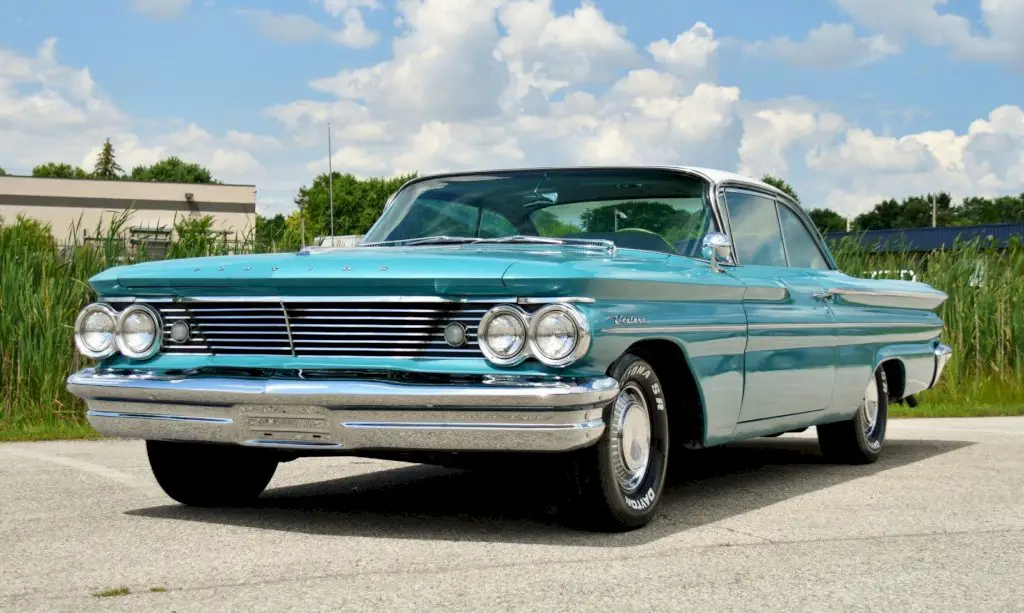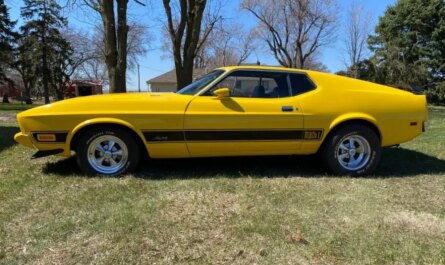The 1960 Pontiac Ventura stands as a testament to the golden age of American automobiles, showcasing an era when style, performance, and innovation were the hallmarks of motor vehicle design. As a full-sized car that was part of the extensive Pontiac lineup of the time, the Ventura captured the hearts of car enthusiasts with its striking design and powerful engine options.
-1686726607x1024.jpg)
In this comprehensive guide, we will delve into the history, design, features, and performance of the 1960 Pontiac Ventura, revealing why this classic car continues to be admired by automobile aficionados.
1. A Brief History of the Pontiac Ventura
The Pontiac Ventura was introduced in 1960 as a new model in the brand’s full-sized lineup, which also included the Catalina, Star Chief, and Bonneville. The Ventura was produced for two model years – 1960 and 1961-before being replaced by the Pontiac Grand Prix in 1962.
2. Design
The 1960 Pontiac Ventura was a stylish and iconic car from the 1960s. Known for its sleek lines, chrome accents, and powerful engine, it represented the design trends of the era. Here’s a description of the design elements of the 1960 Pontiac Ventura:
Exterior
The 1960 Ventura had a long and low profile, emphasizing its aerodynamic design. The front end featured a wide, horizontally divided grille with prominent horizontal chrome bars. The grille extended to the edges of the fenders, giving the car a wide and aggressive look.
-1686726663x1024.jpg)
Dual headlights were placed horizontally on each side of the grille, integrated into the fender design. The body had smooth lines, with a gently sloping roofline and a curved rear end. The rear fenders had a slight fin-like appearance.
Chrome accents were prominent throughout the exterior, including on the bumpers, window trim, and side moldings. The rear of the car had distinctive taillights, featuring a vertical array of round lights on each side, which wrapped around the rear fenders. The overall design of the car exuded a sense of elegance and sophistication, with a touch of sportiness.
Interior
The interior of the 1960 Pontiac Ventura was designed for comfort and style. The dashboard had a clean and symmetrical layout, featuring a combination of chrome accents and polished wood veneer.
-1686726681.jpg)
The instrument panel included a speedometer, fuel gauge, temperature gauge, and other essential dials and switches. The seating was upholstered in high-quality materials, offering both comfort and support. The front seats were typically bench-style, while bucket seats were available as an option.
The interior color schemes were varied, ranging from classic combinations of black and white to vibrant two-tone color options. Optional features included air conditioning, power windows, and power-adjustable seats, among others.
3. Engine and Performance
The 1960 Pontiac Ventura offered a range of engine options, providing varying levels of performance. Here are the engine options and their respective performance characteristics:
Standard Engine
The standard engine for the 1960 Pontiac Ventura was a 389 cubic inch (6.4-liter) V8 engine. It was equipped with a two-barrel carburetor and produced around 283 horsepower. The Ventura with the standard engine offered respectable performance and provided a smooth and enjoyable driving experience.
-1686726695.jpg)
Tri-Power 389 V8
An optional engine for the 1960 Pontiac Ventura was the Tri-Power 389 V8. This engine featured a three two-barrel carburetor setup, commonly known as “Tri-Power.”
Depending on the specific configuration and tune, the Tri-Power 389 V8 produced different power outputs ranging from 303 to 348 horsepower. The Tri-Power setup provided increased power and improved performance compared to the standard engine, resulting in quicker acceleration and higher top speeds.
-1686726710.jpg)
Super Duty 389 V8
The Super Duty 389 V8 was a high-performance engine option available for the 1960 Pontiac Ventura. It was a limited production engine designed for racing and special applications.
The Super Duty 389 V8 featured upgraded internals, high-flow cylinder heads, and a high-lift camshaft. The specific power output of the Super Duty engine varied depending on the configuration and modifications made, but it could exceed 360 horsepower. With the Super Duty engine, the Ventura achieved impressive acceleration and higher top speeds, delivering an exhilarating driving experience.
-1686726732x1024.jpg)
In terms of performance, the 1960 Pontiac Ventura offered a range of power levels depending on the chosen engine. The Tri-Power and Super Duty engines provided increased performance capabilities compared to the standard V8 engine, allowing for quicker acceleration and higher top speeds. The exact performance figures (such as acceleration times and top speeds) can vary based on various factors, including engine tuning, transmission, rear axle ratio, and other modifications.
4. Sales and Production
Sales Performance
Despite being a new model for 1960, the Pontiac Ventura performed reasonably well in terms of sales. The combination of the Ventura’s attractive styling, luxurious features, and competitive pricing helped to make it a popular choice among buyers seeking a full-size automobile with a touch of luxury.
-1686726748x1024.jpg)
However, the Ventura’s sales were still significantly lower than those of the more affordable and well-established Catalina. While the exact sales figures for the 1960 Ventura are difficult to determine, it is estimated that the car accounted for a relatively small percentage of Pontiac’s overall sales for the 1960 model year.
Production and Model Availability
The 1960 Pontiac Ventura was available in two body styles: a two-door hardtop coupe, known as the “Sport Coupe,” and a four-door hardtop sedan, known as the “Vista.” These two models were built on the same B-body platform as the Catalina and shared many of the same mechanical components and design elements.
-1686726763.jpg)
Pontiac’s production facilities in the United States and Canada produced the Ventura, along with other full-size Pontiac models, for the North American market. The exact production numbers for the 1960 Ventura are difficult to pinpoint, as Pontiac’s records from this era often included the Ventura’s production figures within the broader Catalina production numbers.
5. Legacy and End of 1960 Pontiac Ventura
The 1960 Pontiac Ventura left a lasting legacy within the Pontiac brand and the automotive industry. While it started as a trim level within the Pontiac Catalina lineup, it eventually became a distinct model of its own. Here’s a look at the legacy and end of the 1960 Pontiac Ventura:
Legacy
The 1960 Pontiac Ventura played a significant role in Pontiac’s lineup during its production years. Its stylish design, powerful engine options, and luxurious features contributed to its popularity among car enthusiasts.
-1686726775x1024.jpg)
The Ventura showcased Pontiac’s commitment to offering performance-oriented vehicles with a touch of luxury. It helped establish Pontiac’s reputation as a brand that catered to drivers seeking a balance of power, style, and comfort.
Evolution and Successors
Following the 1960 model year, the Ventura nameplate continued to be used by Pontiac. The Ventura evolved as a distinct model, separate from the Catalina lineup, in subsequent years. The Ventura models that followed the 1960 version underwent design updates and changes in line with evolving automotive trends.
-1686726794.jpg)
Discontinuation
Eventually, the Ventura nameplate was discontinued in the late 1970s. Shifting market demands, fuel economy concerns, and changing consumer preferences contributed to the discontinuation. Pontiac replaced the Ventura with other models, such as the Pontiac Phoenix, which catered to the evolving market needs.
Collectibility and Enthusiast Following
The 1960 Pontiac Ventura, particularly in its later years as a distinct model, holds a special place in the hearts of Pontiac enthusiasts and collectors. Its unique styling, performance options, and place in Pontiac’s history have made it desirable among car enthusiasts. Well-preserved or restored examples of the 1960 Pontiac Ventura can command attention and value among collectors.
Although the 1960 Pontiac Ventura’s production eventually came to an end, its legacy as a stylish, performance-oriented, and luxurious model lives on. Its contributions to Pontiac’s lineup and its appeal to enthusiasts ensure that it remains a notable part of automotive history.
6. Cultural Values
The 1960 Pontiac Ventura reflected several cultural values prevalent during that era. Here are some cultural values associated with the 1960 Pontiac Ventura:
Style and Sophistication
The 1960s were a time of increasing focus on aesthetics and personal style. The Pontiac Ventura’s sleek design, chrome accents, and attention-grabbing front grille embodied the desire for stylish and sophisticated automobiles. Owning a Ventura allowed individuals to express their sense of fashion and personal flair.
Luxury and Comfort
The 1960s witnessed a rise in the desire for comfort and luxury in automobiles. The Pontiac Ventura, positioned as a more upscale trim level, offered a range of luxurious features and high-quality materials. Comfortable seating, refined interiors, and optional amenities provided a sense of indulgence and refinement. The cultural value of seeking a higher standard of living was reflected in the desire for a well-appointed and comfortable vehicle.
-1686726838x1024.jpg)
Status and Prestige
In the 1960s, owning a car was often associated with social status and prestige. The Pontiac Ventura, with its stylish design and powerful engine options, represented a level of exclusivity and sophistication. Owning a Ventura signaled one’s ability to afford a desirable and premium vehicle, reflecting a cultural value of success and achievement.
Individualism and Personal Expression
The 1960s marked a period of increased individualism and personal expression. The Pontiac Ventura offered various customization options, allowing buyers to tailor the car to their preferences.
-1686726853.jpg)
Customers could choose from different engine options, transmissions, and additional features, enabling them to create a vehicle that reflected their unique identity and tastes.
The 1960 Pontiac Ventura embodied cultural values of style, performance, luxury, status, and individualism prevalent during the era. It provided a means for individuals to express their aspirations, personal style, and desire for a powerful and stylish vehicle that reflected their lifestyle and values.



